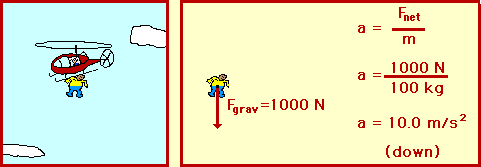Newton's Laws
Skydiving
Observe the motion of the skydiver below. As the skydiver falls,
he encounters the force of air resistance. The amount of air
resistance is dependent upon two variables:
- the speed of the skydiver, and
As a skydiver falls, he accelerates downwards, gaining speed
with each second. The increase in speed is accompanied by an
increase in air resistance (as observed in the animation below).
This force of air resistance counters the force of gravity. As the
skydiver falls faster and faster, the amount of air resistance
increases more and more until it approaches the magnitude of the
force of gravity. Once the force of air resistance is as large as
the force of gravity, a balance of forces is attained and the
skydiver no longer accelerates. The skydiver is said to have
reached a terminal velocity.
- the cross-sectional area of the skydiver.
A skydiver in the spread eagle position encounter more air
resistance than a skydiver who assumes the tuck position or who
falls feet (or head) first. The greater cross-sectional area of a
skydiver in the spread eagle position leads to a greater air
resistance and a tendency to reach a slower terminal velocity. The
importance of cross-sectional area to skydiving is also
demonstrated by the use of a parachute. An open parachute
increases the cross-sectional area of the falling skydiver and
thus increases the amount of air resistance which he encounters
(as observed in the animation below). Once the parachute is
opened, the air resistance overwhelms the downward force of
gravity. The net force and the acceleration on the falling
skydiver is upward. An upward net force on a downward falling
object would cause that the object to slow down. The skydiver thus
slows down. As the speed decreases, the amount of air resistance
also decreases until once more the skydiver reaches a terminal
velocity.

For more information on physical descriptions of motion, visit
The Physics Classroom Tutorial.
Specific information is available on the following topics:
|